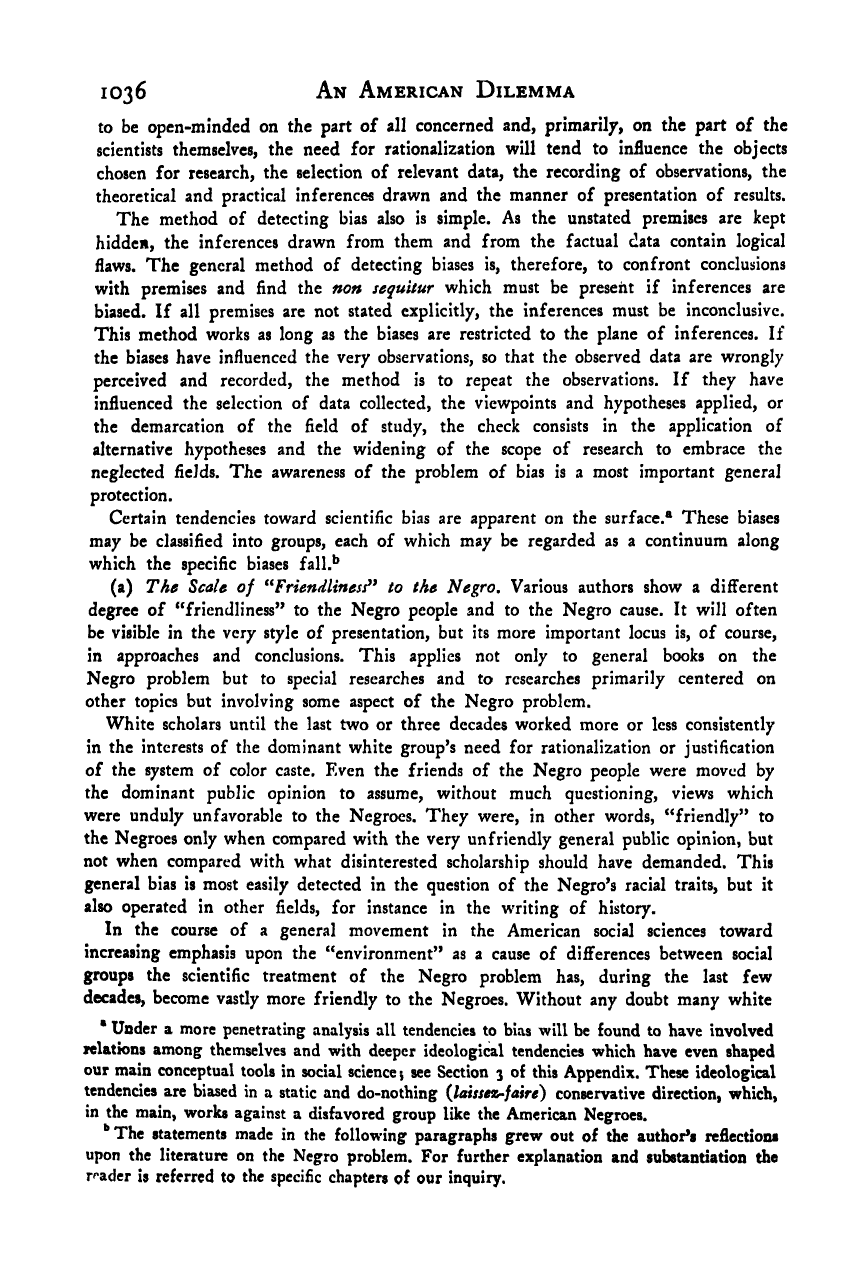Note: Gunnar Myrdal died in 1987, less than 70 years ago. Therefore, this work is protected by copyright, restricting your legal rights to reproduce it. However, you are welcome to view it on screen, as you do now. Read more about copyright.
Full resolution (TIFF) - On this page / på denna sida - Appendices - 2. A Methodological Note on Facts and Valuations in Social Science - 1. Biases in the Research on the American Negro Problem

<< prev. page << föreg. sida << >> nästa sida >> next page >>
Below is the raw OCR text
from the above scanned image.
Do you see an error? Proofread the page now!
Här nedan syns maskintolkade texten från faksimilbilden ovan.
Ser du något fel? Korrekturläs sidan nu!
This page has never been proofread. / Denna sida har aldrig korrekturlästs.
1036 An American Dilemma
to be open-minded on the part of all concerned and, primaril7, on the part of the
scientists themselves, the need for rationalization will tend to influence the objects
chosen for research, the selection of relevant data, the recording of observations, the
theoretical and practical inferences drawn and the manner of presentation of results.
The method of detecting bias also is simple. As the unstated premises are kept
hidden, the inferences drawn from them and from the factual data contain logical
flaws. The general method of detecting biases is, therefore, to confront conclusions
with premises and find the non sequitur which must be present if inferences are
biased. If all premises are not stated explicitly, the inferences must be inconclusive.
This method works as long as the biases are restricted to the plane of inferences. If
the biases have influenced the very observations, so that the observed data are wrongly
perceived and recorded, the method is to repeat the observations. If they have
influenced the selection of data collected, the viewpoints and hypotheses applied, or
the demarcation of the field of study, the check consists in the application of
alternative hypotheses and the widening of the scope of research to embrace the
neglected fields. The awareness of the problem of bias is a most important general
protection.
Certain tendencies toward scientific bias are apparent on the surface.® These biases
may be classified into groups, each of which may be regarded as a continuum along
which the specific biases fall.**
(a) The Scale of Friendliness* to the Negro, Various authors show a different
degree of “friendliness” to the Negro people and to the Negro cause. It will often
be visible in the very style of presentation, but its more important locus is, of course,
in approaches and conclusions. This applies not only to general books on the
Negro problem but to special researches and to researches primarily centered on
other topics but involving some aspect of the Negro problem.
White scholars until the last two or three decades worked more or less consistently
in the interests of the dominant white group’s need for rationalization or justification
of the system of color caste. Even the friends of the Negro people were moved by
the dominant public opinion to assume, without much questioning, views which
were unduly unfavorable to the Negroes. They were, in other words, “friendly” to
the Negroes only when compared with the very unfriendly general public opinion, but
not when compared with what disinterested scholarship should have demanded. This
general bias is most easily detected in the question of the Negro’s racial traits, but it
also operated in other fields, for instance in the writing of history.
In the course of a general movement in the American social sciences toward
increasing emphasis upon the “environment” as a cause of differences between social
groups the scientific treatment of the Negro problem has, during the last few
decades, become vastly more friendly to the Negroes. Without any doubt many white
• Under a more penetrating analysis all tendencies to bias will be found to have involved
relations among themselves and with deeper ideological tendencies which have even shaped
our main conceptual tools in social science ^ see Section 3 of this Appendix. These ideological
tendencies are biased in a static and do-nothing {laisse^fatre) conservative direction, which,
in the main, works against a disfavored group like the American Negroes.
*’The statements made in the following paragraphs grew out of the author’s reflections
upon the literature on the Negro problem. For further explanation and substantiation the
r^’ader is referred to the specific chapters of our inquiry.
<< prev. page << föreg. sida << >> nästa sida >> next page >>